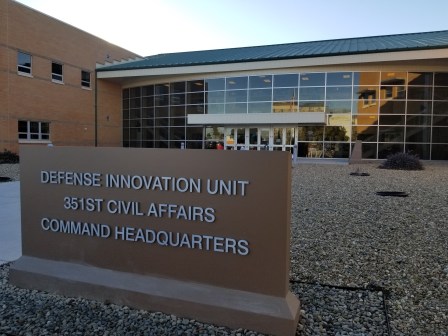Defense Innovation Board calls on DOD to reorganize, launch new undersecretariat

Facing confusion from industry, allies and partners about how they can best engage with military components and understand contractual and decision-making structures, the Defense Innovation Board is calling on Pentagon leadership to launch an internal reorganization and establish a new undersecretariat focused on international industrial cooperation.
During their open meeting on Wednesday, members of the panel agreed upon those and other recommendations, based on a study they were tasked with delivering, called Optimizing Innovation Cooperation with Allies and Partners.
“Today, the DoD does not have a central standing mechanism for interfacing with allies, partners, and international organizations, resulting in a state of considerable fragmentation, duplication, and lack of coordination across workstreams. Moreover, we observed that DoD senior leaders are stretched thin by the many duties pressed upon them, and that international defense industrial cooperation is often relegated in the face of competing priorities. The Department’s principals responsible for international cooperation accordingly struggle to devote an adequate level of attention, care, and focus to addressing the barriers and risks facing the international industrial base,” the report stated.
At Wednesday’s meeting, board member Charles Phillips said: “We talked to a lot of different organizations to get a sense of how it’s working today. Other countries [like] Norway, the U.K., Ukraine, even our allies, and … some startups trying to work with the DOD from outside of the U.S. and want to find out how to work with us. So, the number one issue we found is that there’s no pathway for working with the DOD if you’re coming from another country. No one knows how it works. It’s too fragmented and there’s a lot of different certifications and requirements.”
To help tackle these problems, the DIB recommends that the Pentagon create an Undersecretary of Defense for International Industrial Cooperation, or USD(IIC), and designate a senior political executive to serve as the department’s primary point of contact and report as the principal staff assistant to defense leadership for all matters pertaining to international defense industrial cooperation.
Two assistant secretaries of defense for combined requirements development and international integration and interoperability should serve under the new undersecretary’s purview, the study suggests.
In early 2018, Congress mandated that the department reshuffle the Undersecretary of Defense for Acquisition, Technology and Logistics (AT&L) into undersecretary-level positions focused on acquisition and sustainment (A&S) and research and engineering (R&E). That move was controversial at the time — and in their study, DIB experts said it “left the international defense industrial cooperation portfolio disjointed.”
As part of their proposed reshuffle, board members recommend that the new ICC office “incorporate and elevate the international defense industrial base portfolio” from A&S. Oversight of all domestic defense industrial base policy would remain under the acquisition and sustainment directorate.
Similarly, under the new structure IIC would adopt the research and engineering directorate’s international outreach and policy portfolio “with primary oversight of implementation of the DOD’s international science and technology engagement efforts.”
The panelists also recommend that other DOD components that engage in international industrial cooperation activities — and in particular the Defense Innovation Unit and Chief Digital and Artificial Intelligence Office — “should be nested with the priorities dictated by the USD(IIC).”
Presenting an alternative option, the researchers wrote that “in place of a new undersecretary, Congress may consider reconsolidating the USD(A&S) and USD(R&E) into an Undersecretary for the Industrial Base focusing on innovation research and development, supply chains, production capacity, and access to technologies both domestically and globally.”
Ultimately, the Pentagon won’t be able to shift its structure based on these recommendations without new directions from congressional lawmakers, which likely wouldn’t come without some debate.
“I participated in that decision [regarding the 2018 restructure] and I’ve got qualms on going back — because I know the arguments back and forth and [we] came to a different conclusion. Having said that, I think the study is absolutely on the right track [and] in all other areas should be supported. And again, it highlights a very important issue that not a lot of other studies have,” DIB member and former congressman William “Mac” Thornberry said during Wednesday’s meeting.
The panelists who conducted the study reflected on why they recommended the reorganization within the Office of the Secretary of Defense.
Based on his experiences in the Marines and now as a technology investment executive, Phillips said the U.S. military’s allies and partners need one single point of contact within DOD, as well as integrated designs and manufacturing capacity.
“This is all in the report as well — in 37 of the 44 critical technologies identified by a third-party research organization, China is leading. If you look at high-end systems adoption, they’re moving 6x faster. They’re now coordinating with Russia, North Korea, and the three of them, collectively, [are] at 1.6 billion citizens. So, the rate and scale of their investment has just changed. And so one way to respond to that is we could collectively work with our partners. We can recreate that scale in a different way. So what does that mean? It means shared systems and equipment, but also shared data,” Phillips explained.
During Wednesday’s meeting, Navy Capt. Colin Kane also discussed his team’s ongoing work in DOD’s Joint Rapid Acquisition Cell.
The cell’s responsibilities include the department’s joint urgent operational needs, which are essentially critical requirements identified by combatant commanders.
“I think one of the challenges there is that innovation is also slow, and so we’re supposed to field solutions within two years to those environments, but it’s an extremely challenging thing to achieve there,” Kane said.
In his own experiences as a DOD acquisition professional, Kane said he’s also seeing challenges around industry cooperation with the research and engineering directorate “to be able to field urgent needs for the counter-uncrewed system threat.”
“In that environment, we’re seeing extremely quick innovation and in partnership with the research and engineering directorate, there isn’t the — since we separated A&S from R&E, we aren’t seeing the ability to or effective means of communication to move in that effort,” Kane said. “In combining those two organizations, there would be benefits.”
At the meeting, NATO’s Acting Assistant Secretary General, Innovation, Hybrid, and Cyber James Appathurai also spotlighted the need for the U.S. and its allies to collectively speed up the adoption of emerging and disruptive technologies.
He noted that there’s now “a two-week innovation cycle for software in Ukraine.”
“They’re putting a certain amount of software into drones. It’s being neutralized by the Russians in two weeks, and then they have to come up with a new innovation and new technology. So that’s the speed of the war, and we certainly need to accelerate that at NATO. So, we are now turning our attention to that,” Appathurai said.






